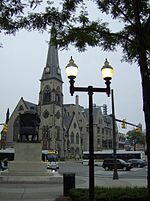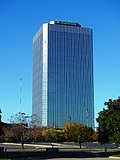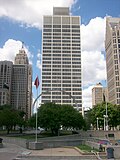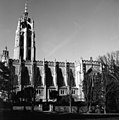Architecture of metropolitan Detroit
The architecture of metropolitan Detroit continues to attract the attention of architects and preservationists alike.
Detroit's architecture is recognized as being among the finest in the U.S. Detroit has one of the largest surviving collections of late-19th- and early-20th-century buildings in the U.S.[3] Because of the city's economic difficulties, the National Trust for Historic Preservation has listed many of Detroit's skyscrapers and buildings as some of America's most endangered landmarks.[4]
The suburbs contain some significant contemporary architecture and several historic estates.[5][6]
Skyscrapers

In the 1880s,
At 12 stories, the steel-framed United Way Community Services Building (1895), at 1212 Griswold, originally known as the Chamber of Commerce Building, qualifies as Detroit's oldest existing skyscraper.[6][10] The 10-story Hammond Building (1889), now demolished, is considered the city's first historic skyscraper.[11] The Qube in the Detroit Financial District was developed on the Hammond Building site.[12]
The city has numerous architecturally significant late-19th- and early-20th-century buildings and skyscrapers.
Detroit has preserved numerous historic buildings that are listed on the
During the
The city's architectural legacy is rich in Art Deco style, with buildings constructed during the boom years of the 1920s. Joseph L. Hudson, the department store magnate, had commissioned architect Hugh Ferriss to produce a series of renderings depicting new buildings for the city skyline.[15] Hudson's Department Store window displayed the Ferriss drawings to commemorate its fiftieth anniversary, and to celebrate the opening in 1927 of a new building for the Detroit Institute of Arts, a Beaux-Arts, Italian Renaissance-styled structure.[15] Other architects created designs inspired by the Hugh Ferriss concepts, which included the Guardian Building, the David Stott Building, the J.L Hudson Building, and others.[13][15]
The seven Fisher brothers, who owned the automotive company Fisher Body, essentially gave architect Kahn a blank check to design and build the "most beautiful building in the world."[16] This was the Fisher Building (1927) which, with its detailed work, has been called the city's "largest art object." Its opulent three-story, barrel-vaulted lobby is constructed with forty different kinds of marble.[16][17][18] Albert Kahn Associates chief architect for the Fisher Building was Joseph Nathaniel French.[19] The Fisher Building and Cadillac Place are among the National Historic Landmarks in Detroit anchoring the city's historic New Center.
Architect
Tallest buildings
| Rank | Building | Height | Stories | Built | Notes | |
|---|---|---|---|---|---|---|
| 1 | Detroit Marriott at the Renaissance Center | 727 feet (222 m) | 73 | 1977 | [20] | |
| 2 | One Detroit Center |
619 feet (189 m) | 43 | 1993 | [21] | |
| 3 | Penobscot Building | 565 feet (172 m) | 47 | 1928 | [22] | |
| T-4 | Renaissance Center Tower 100 | 522 feet (159 m) | 39 | 1977 | [23] | |
| T-4 | Renaissance Center Tower 200 | 522 feet (159 m) | 39 | 1977 | [24] | |
| T-4 | Renaissance Center Tower 300 | 522 feet (159 m) | 39 | 1977 | [25] | |
| T-4 | Renaissance Center Tower 400 | 522 feet (159 m) | 39 | 1977 | [26] | |
| 8 | Guardian Building | 496 feet (151 m) | 40 | 1929 | [27] | |
| 9 | Book Tower | 475 feet (145 m) | 38 | 1926 | [28] | |
| 10 | 150 West Jefferson | 455 feet (139 m) | 26 | 1989 | [29] |
Contemporary highlights
The Detroit area also contains prominent skycrapers designed in the

The office market in Metro Detroit is one of the nation's largest. with 147.88 million square feet (13,739,000 m2).[31] The Renaissance Center, with 5.552 million square feet (515,800 m2), and the Southfield Town Center, with 2.2 million square feet (204,400 m2), are large-scale examples of Contemporary Modern skyscraper complexes. Each mixed-use complex is an interconnected group of skyscrapers termed a "city within a city."
The construction of the
Portman expanded on his earlier design for the
In 1924, Detroit's
Stemming the flight of capital from the city proved difficult, however, as the suburban office market continued to grow, notably in Southfield and Troy. The Southfield Town Center, constructed from 1975 to 1989, became easy to recognize with its marque of five golden glass skyscrapers. It attracted tenants in competition with the Renaissance Center as Metro Detroit's office market continued its suburban expansion.
Portman designed the Renaissance Center with interior spaces, yet secure. It quickly became a symbol of the city of Detroit. In 1996, the
The city, together with the Riverfront Conservancy, undertook another major project planned at $559-million along the Detroit International Riverfront to construct a three-mile (5 km) riverfront promenade park along the east river from
Besides the
The suburb of Auburn Hills is home to the 15-story
Future development

Between 1996 and 2006, downtown Detroit attracted more than $15 billion in new investment from private and public sectors.
In January 2008, the City of Detroit unveiled a concept for a new
Landmarks and monuments
Founded in 1701, Detroit contains the second oldest
The
The large concentration of
Campus Martius
The city and its surrounding area have numerous monuments by noted architects and sculptors along tree-lined boulevards and parks just some of which are noted.
Grand Circus

In 1805, Detroit experienced a devastating fire, which destroyed most of the city's
Detroit's
Neo-Renaissance and Neo-Classical

In the late 19th century, Detroit was called the Paris of the West for its architecture and open public spaces,[45] in keeping with the City Beautiful movement.[55] Architects John and Arthur Scott designed the Wayne County Building (1897) in downtown Detroit. Expense was not a factor in construction of its lavish design. Topped with bronze quadrigas by J. Massey Rhind and an Anthony Wayne pediment by Edward Wagner, it may be America's finest surviving example of Roman Baroque architecture with a blend of Beaux-Arts.[5] Stanford White, architect of Newport, Rhode Island's Rosecliff mansion, designed Detroit's Neoclassical Savoyard Centre (1900) at 151 Fort St. Belle Isle Park provides panoramic views of city skyline along the Detroit International Riverfront.
The French-American architect

The Detroit area is home to light houses,
Metro Detroit's many architecturally significant landmarks extend beyond the city and include the French Gothic St. Paul on the Lake Catholic Church (1899) by Harry J. Rill in Grosse Pointe Farms, Kirk in the Hills Presbyterian (1958) in Bloomfield Hills by Wirt C. Rowland, and Christ Church Cranbrook (1928) by Bertram Goodhue in Bloomfield Hills.[6]
Residential architecture

Downtown and New Center areas contain high-rise buildings, while the majority of the surrounding city consists of low-rise structures and single-family homes. The city's neighborhoods constructed prior to World War II feature the architecture of the times with wood frame and brick houses, larger brick homes in middle-class neighborhoods, and ornate mansions throughout the city's many historic districts and nearby suburbs such as Grosse Pointe. The oldest city neighborhoods are along the Woodward and Jefferson corridors, while newer city neighborhoods are found in the west and northeast.
High-rise residential buildings are found in neighborhoods along the
Some of the oldest extant working-class neighborhoods include those in the Southwest such
Detroit neighborhood historic districts contain notable residential architecture from the
Detroit's heritage includes works by Frank Lloyd Wright who had participated in the initial design for Henry Ford's Fair Lane Estate,[68] a National Historic Landmark in Dearborn. Frank Lloyd Wright also designed the Dorothy H. Turkel House at 2760 West Seven Mile Rd.,[69] the Gregor S. and Elizabeth B. Affleck House at 1925 N. Woodward Ave., the Melvyn Maxwell and Sara Stein Smith House at 5045 Ponvalley Rd., and the Carlton D. Wall House at 12305 Beck Rd. in Plymouth Township.

The mansions of metropolitan Detroit are among the nation's grandest estates.
There have also been some newer redeveloped upscale subdivisions in the Grosse Pointe, Bloomfield Hills, and Turtle Lake areas.[5][6][74]
Photo gallery
Skyscrapers
|
|---|
Landmarks
|
|---|
Monuments[48][49]
|
|---|
Architectural sculpture
|
|---|
Citations
- ^ Aryamonti, Deborah Chatr (2006). "Review of Detroit and Rome: building on the past". Bryn Mawr Classical Review. Bryn Mawr Classical Review 2006.10.43. Retrieved November 24, 2007.
- ^ Detroit News (November 6, 2005).Detroit, ancient Rome share past.Model D Media. Retrieved on August 12, 2008.
- ^ ISBN 0-8143-3270-6.
- ^ Publisher review of American City: Detroit Architecture Archived 2011-07-16 at the Wayback Machine. Retrieved on November 24, 2007.
- ^ ISBN 0-8143-1651-4.
- ^ ISBN 978-0-8143-3120-0.
- ^ "Wilson Eyre, Jr". University Archives and Records Center. Retrieved 2023-04-18.
- ^ "Detroit Club | Detroit Historical Society". detroithistorical.org. Retrieved 2023-04-18.
- ^ Randolph Street Commercial Buildings Historic District Archived 2011-06-06 at the Wayback Machine from the state of Michigan, retrieved 01/02/11
- ^ United Way Community Services Building[usurped].Emporis.com. Retrieved on November 23, 2007.
- ^ "Hammond Building". Emporis.com. Archived from the original on November 1, 2004. Retrieved 2007-11-05.
- ^ The Qube[usurped]. Emporis. Retrieved May 1, 2012.
- ^ a b c Ferry, W. Hawkins, The Buildings of Detroit: A History, Wayne State University Press, Detroit, Michigan, 1968
- ^ a b c Zacharias, Pat (March 9, 2001). Guardian Building has long been the crown jewel in the Detroit skyline. Michigan History, The Detroit News. Retrieved on April 12, 2014.
- ^ ISBN 978-0-8143-3385-3.
- ^ a b Houston, Kay and Linda Culpepper (March 20, 2001).The most beautiful building in the world Michigan History, The Detroit News. Retrieved on November 23, 2007
- ^ Mazzei, Rebecca (November 30, 2005).Still Standing. Metro Times. Retrieved on November 23, 2007.
- ^ AIA Detroit Urban Priorities Committee, (January 10, 2006).Top 10 Detroit Interiors.Model D Media. Retrieved on November 23, 2007.
- ^ "Joseph N. French, Fairlane Architect". Detroit Free Press. March 2, 1975.
A graduate of the Massachusetts Institute of Technology, he came to Detroit in 1913 to work as an architect on Henry Ford's home, Fairlane. He joined the architectural firm of Albert Kahn Associates in 1914 and retired from that company in 1967. In the meantime he had served as chief architect for the Fisher Building, taught methods of industrial construction in Russia and during World War II, designed installations for the Army and Navy throughout the world.
- ^ "Detroit Marriott at the Renaissance Center". SkyscraperPage.com. Retrieved 2008-08-05.
- ^ "One Detroit Center". SkyscraperPage.com. Retrieved 2008-08-05.
- ^ "Penobscot Building". SkyscraperPage.com. Retrieved 2008-08-05.
- ^ "Renaissance Center Tower 100". SkyscraperPage.com. Retrieved 2008-08-05.
- ^ "Renaissance Center Tower 200". SkyscraperPage.com. Retrieved 2008-08-05.
- ^ "Renaissance Center Tower 300". SkyscraperPage.com. Retrieved 2008-08-05.
- ^ "Renaissance Center Tower 400". SkyscraperPage.com. Retrieved 2008-08-05.
- ^ "Guardian Building". SkyscraperPage.com. Retrieved 2008-08-05.
- ^ "Book Tower". SkyscraperPage.com. Retrieved 2008-08-05.
- ^ "150 West Jefferson". SkyscraperPage.com. Retrieved 2008-08-05.
- ^ Baulch, Vivian M. (August 14, 1998)."Minoru Yamasaki, world-class architect". Michigan History, The Detroit News. Retrieved on November 23, 2007.
- ^ Metro Detroit Office Market report. Colliers International. Retrieved on August 16, 2008.
- ^ a b Official World's 100 Tallest High Rise Buildings (Hotel Use)[usurped]. Emporis.com. Retrieved on May 30, 2008.
- ^ Mercer, Tenisha (October 19, 2005).GM's RenCen renovation attracts new business back. Detroit News. Retrieved on July 24, 2007.
- ^ Detroit News Editorial (December 13, 2002). At Last, Sensible Dream for Detroit's Riverfront. Detroit News.
- ^ Priddle, Alisa (May 12, 2009).Chrysler's tech center called a 'good asset'. The Detroit News. Retrieved on June 28, 2009.
- ^ Madeleine, Stix. "Implosion levels the Palace of Auburn Hills, the Detroit Pistons' former home". CNN.com. CNN. Retrieved 29 January 2025.
- ^ a b The Urban Markets Initiative, Brookings Institution Metropolitan Policy Program The Social Compact, Inc. University of Michigan Graduate Real Estate Program (October 2006).Downtown Detroit In Focus: A Profile of Market Opportunity Archived September 18, 2011, at the Wayback Machine. Downtown Detroit Partnership. Retrieved on January 4, 2011.
- ^ a b Howes, Daniel (November 13, 2007).Quicken to move to Detroit. The Detroit News. Retrieved on June 23, 2009.
- ^ July 4, 2007 Detroit News Archived September 28, 2007, at the Wayback Machine Downtown Detroit Partnership
- ^ Ann Arbor - Detroit Regional Rail Project SEMCOG. Retrieved on February 4, 2010.
- ^ PRNewswire (January 6, 2008).Detroit Gets New Era in Downtown Living With Iconic $150 Million Cadillac Centre on Campus Martius Park. Retrieved on January 13, 2008.
- ^ Hyde, Charles (May–June 1991).Demolition by Neglect: The Failure to Save the Monroe Block Archived January 14, 2008, at the Wayback Machine.Michigan History Magazine. Retrieved on January 20, 2008.
- ^ CB Richard Ellis - The Pavilions of Troy[permanent dead link]
- ^ Automation Alley Technology Industry Report (2011 Edition) Archived 2015-07-05 at the Wayback Machine.Anderson Economic Group. Retrieved July 31, 2011.
- ^ a b c Woodford, Arthur M. (2001). This is Detroit: 1701–2001. Wayne State University Press.
- ^ Sweetest Heart of Mary Catholic Church from Detroit1701.org
- ^ Foot, Andrew (June 29, 2006).International Metropolis Archived November 12, 2009, at the Wayback Machine. Cathedral of the Most Blessed Sacrement. Diehl & Diehl Archives, photo inside Corrado Parducci's studio. Retrieved on July 24, 2009.
- ^ a b c d e Zacharias, Pat (September 5, 1999). Monuments of Detroit. Michigan History, Detroit News. Retrieved on November 21, 2007.
- ^ a b c Monuments and Sculptures in Detroit Archived July 9, 2011, at the Wayback Machine. Detroit Historical Society. Retrieved on March 27, 2008.
- ^ Condit, Julie (May 6, 2000).Campus Martius — city's heart may beat again. The Detroit News. Retrieved on August 12, 2008.
- ^ Campus Martius Park. Detroit's Gathering Place — Park Grounds. Retrieved on August 12, 2008.
- ^ Baulch, Vivian M. (June 13, 1999). Woodward Avenue, Detroit's Grand old "Main Street" Archived 2009-01-04 at archive.today Michigan History, The Detroit News. Retrieved on November 23, 2007.
- ^ Hodges, Michael H. (September 8, 2003).Fox Theater's rebirth ushered in city's renewal Archived December 5, 2012, at archive.today. Michigan History, The Detroit News. Retrieved on November 23, 2007.
- ^ DiChiera, David, Director.The Story of the Detroit Opera House Archived April 23, 2008, at the Wayback Machine.Michigan Opera Theatre. Retrieved on August 12, 2008.
- ^ Bluestone, Daniel M., Columbia University, (September 1988).Detroit's City Beautiful and the Problem of Commerce Journal of the Society of Architectural Historians, Vol. XLVII, No. 3, pp. 245–62. Retrieved on May 18, 2007.
- ^ Lighthouses of the Great Lakes Archived October 9, 2007, at the Wayback Machine. Retrieved on November 23, 2007.
- ^ Chauncey Hurlbut Memorial Gate Archived October 18, 2006, at the Wayback Machine Detroit 1701.org. Retrieved on November 24, 2007.
- ^ Public Art and Sculpture, Detroit1701.org. Retrieved on March 28, 2008.
- ^ James Scott Fountain Archived October 29, 2006, at the Wayback Machine Detroit 1701.org. Retrieved on November 24, 2007.
- ^ Baulch, Vivian M. (August 4, 1998).Marshall Fredericks — the Spirit of Detroit Archived July 11, 2012, at archive.today. Michigan History, The Detroit News. Retrieved on November 23, 2007.
- ^ Baulch, Vivian M. (September 6, 1999).Carl Milles, Cranbrook's favorite sculptor. Michigan History, The Detroit News. Retrieved on November 23, 2007.
- ^ a b Boston-Edison Historic District Archived July 16, 2011, at the Wayback Machine from the City of Detroit Planning and Development Department.
- ^ Vitullo-Martin, Julio (December 22, 2007).The Biggest Mies Collection: His Lafayette Park residential development thrives in Detroit.The Wall Street Journal. Retrieved on April 21, 2008.
- ^ Detroit Historic Districts Archived 2012-06-15 at the Wayback Machine. Cityscape Detroit. Retrieved on December 16, 2007.
- ^ David Whitney House Archived June 16, 2008, at the Wayback Machine from the national Park Service
- ^ Arden Park-East Boston Historic District. Detroit1701.org. Retrieved on December 16, 2007.
- ^ Arden Park-East Boston Historic District Archived February 8, 2012, at the Wayback Machine. City of Detroit Planning and Development Department. Retrieved on December 16, 2007.
- ^ a b c A&E with Richard Guy Wilson, Ph.D.,(2000). America's Castles: The Auto Baron Estates, A&E Television Network.
- ^ Michael Jackman (26 June 2006).Wright or wrong: Detroit's Turkel house drips with history. Metro Times
- ^ McDonald, Maureen (November 28, 2006).Visit with a Giant. Model D Media. Retrieved on December 23, 2008.
- ^ a b Zacharias, Patricia (June 24, 2000).Mrs. Dodge and the Regal Rose Terrace. Michigan History, The Detroit News. Retrieved on November 23, 2007.
- ^ Grosse Pointe War Memorial, the Russell A. Alger Mansion. Retrieved on November 24, 2007.
- ^ Paul Goldberger (April 8, 1984). "The Cranbrook Vision". The New York Times.
- ^ Turtle Lake in Bloomfield Hills Archived May 27, 2007, at the Wayback Machine. Retrieved on November 24, 2007.
- ^ Strother, Michael Guide to Ann Arbor Architecture Archived July 8, 2007, at the Wayback Machine AIA Michigan. Retrieved on July 21, 2007.
References and further reading
- A&E with Richard Guy Wilson, Ph.D.,(2000). America's Castles: The Auto Baron Estates, A&E Television Network.
- A&E with Richard Guy Wilson, Ph.D.,(2000). America's Castles: Newspaper Moguls, Pittock Mansion, Cranbrook House & Gardens, The American Swedish Institute. A&E Television Network.
- Bridenstine, James (1989). Edsel and Eleanor Ford House. Wayne State University Press. ISBN 0-8143-2161-5.
- Collum, Marla O.; Barbara E. Krueger; Dorothy Kostuch (2012). Detroit's Historic Places of Worship. Wayne State University Press. ISBN 978-0-8143-3424-9.
- Delicato, Armando (2005). Italians in Detroit (Images of America). Arcadia Publishing. ISBN 0-7385-3985-6.
- Eckhert, Katheryn Bishop (1993). Buildings of Michigan (Society of Architectural Historians). New York: Oxford University Press. ISBN 0-19-506149-7.
- Ferry, W. Hawkins (1968). The Buildings of Detroit: A History. Wayne State University Press.
- Fisher, Dale (1996). Ann Arbor: Visions of the Eagle. Grass Lake, Michigan: Eyry of the Eagle Publishing. ISBN 0-9615623-4-X.
- Fisher, Dale (2003). Building Michigan: A Tribute to Michigan's Construction Industry. Grass Lake, Michigan: Eyry of the Eagle Publishing. ISBN 1-891143-24-7.
- Fisher, Dale (2005). Southeast Michigan: Horizons of Growth. Grass Lake, Michigan: Eyry of the Eagle Publishing. ISBN 1-891143-25-5.
- Fisher, Dale (1994). Detroit: Visions of the Eagle. Grass Lake, Michigan: Eyry of the Eagle Publishing. ISBN 0-9615623-3-1.
- Fogelman, Randall (2004). Detroit's New Center. Arcadia. ISBN 0-7385-3271-1.
- Gallagher, John; Balthazar Korab (2008). Great Architecture of Michigan. Wayne State University Press. ISBN 978-0-9816144-0-3.
- Godzak, Roman (2004). Catholic Churches of Detroit (Images of America). Arcadia Publishing. ISBN 0-7385-3235-5.
- Hardwick, M. Jeffrey (2003). Mall Maker: Victor Gruen, Architect of the American Dream. University of Pennsylvania Press. ISBN 0-8122-3762-5.
- Hauser, Michael; Marianne Weldon (2006). Downtown Detroit's Movie Palaces (Images of America). Arcadia Publishing. ISBN 0-7385-4102-8.
- ISBN 0-8143-3120-3.
- Kavanaugh, Kelli B. (2001). Detroit's Michigan Central Station (Images of America). Arcadia Publishing. ISBN 0-7385-1881-6.
- Kvaran, Einar Einarsson, Architectural Sculpture of America, unpublished manuscript
- Matuz, Roger (2007). Albert Kahn, Architect of Detroit. Wayne State University Press. ISBN 978-0-8143-2956-6.
- Nawrocki, Dennis Alan and Thomas J. Holleman (1980). Art in Detroit Public Places. Wayne State University Press.
- ISBN 0-07-050536-5.
- Rodriguez, Michael; Thomas Featherstone (2003). Detroit's Belle Isle Island Park Gem (Images of America). Arcadia Publishing. ISBN 0-7385-2315-1.
- ISBN 0-8143-3270-6.
- Savage, Rebecca Binno; Greg Kowalski (2004). Art Deco in Detroit (Images of America). Arcadia Publishing. ISBN 0-7385-3228-2.
- Sobocinski, Melanie Grunow (2005). Detroit and Rome: building on the past. Regents of the University of Michigan. ISBN 0-933691-09-2.
- Socia, Madeleine; Suzie Berschback (2001). Grosse Pointe: 1890–1930 (Images of America). Arcadia. ISBN 0-7385-0840-3.
- Tottis, James W. (2008). The Guardian Building: Cathedral of Finance. Wayne State University Press. ISBN 978-0-8143-3385-3.
- Tutag, Nola Huse; Hamilton, Lucy (1988). Discovering Stained Glass in Detroit. Wayne State University Press. ISBN 0-8143-1875-4.
- Walt, Irene; Balthazar Korab (2004). Art in Stations. Wayne State University Press. ISBN 0-9745392-0-1.
- Woodford, Arthur M. (2001). This is Detroit 1701–2001. Wayne State University Press. ISBN 0-8143-2914-4.
External links
- AIA Detroit
- Buildings of Detroit (historic) and architects
- Cityscape Detroit
- Detroit 1701
- Detroit Midtown
- Detroit Riverfront Conservancy
- Experience Detroit
- Edsel & Eleanor Ford House
- Grosse Pointe Historical Society
- Henry Ford's Fair Lane Estate
- Images of Metro Detroit
- Model D Media
- New Center Council
- Downtown Detroit Partnership
- Oakland Regional Historic Sites





























![University of Michigan Law School: Lawyers Club (1924) by York and Sawyer — Quadrangle (1933) by Gunnar Birkerts — Library addition (1982) by Quinn Evans[75]](http://upload.wikimedia.org/wikipedia/commons/thumb/1/16/Lawyers_Club.jpg/120px-Lawyers_Club.jpg)
















![Westin Book Cadillac Hotel[76]](http://upload.wikimedia.org/wikipedia/commons/thumb/b/b0/Book_Cadillac_stone_sculpture_2.jpg/120px-Book_Cadillac_stone_sculpture_2.jpg)






